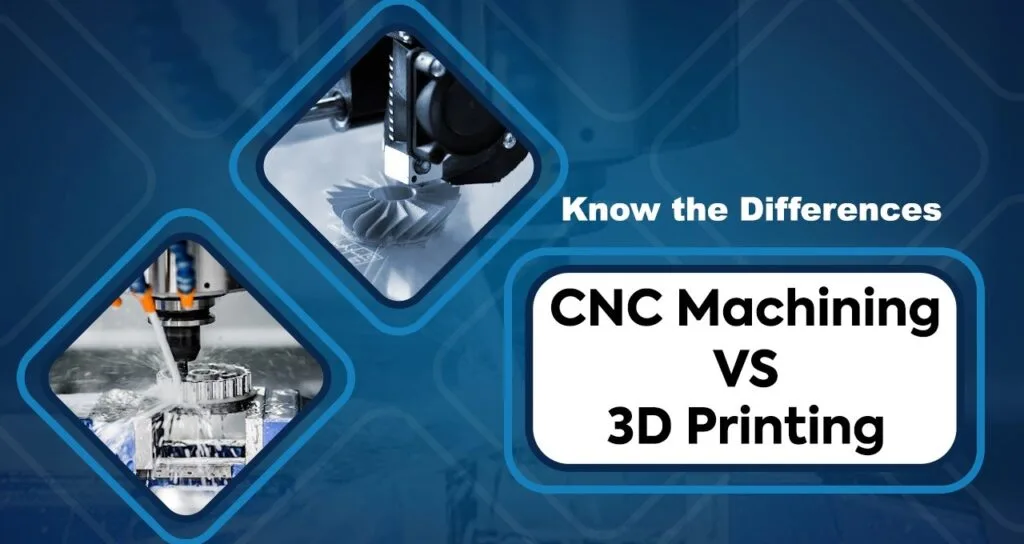Nowadays, product engineers and designers have a lot of options when it comes to manufacturing methods for custom part designs and applications in various sectors, including the aerospace, automotive, and medical industries. But, with too many choices, the two technologies that are best suited for low-volume manufacturing and prototyping part production are 3D printing rapid prototyping and aluminum CNC machining.
Now, your question may be, “How to Decide Between the Two?” Well, there are some key factors you need to consider to understand and evaluate these techniques to identify the right fit for your part manufacturing, and we are going to tell you HOW!

What’s the Difference Between 3D Printing and CNC Machining for Part Manufacturing?
Identifying the right manufacturing technique for your part design and production depends on considering various facts, including:
- Materials available
- Sauce finish qualities
- Costs
- Geometric capabilities of the part
And you need to evaluate all of them before getting a CNC machining prototype service or a 3D printing prototype service. Let’s start with understanding these manufacturing technologies.
CNC machining, a subtractive manufacturing method, designs parts by eliminating materials from a large metal block to create the final parts using 3, 4, and 5-axis CNC milling and CNC turning combined with live tooling, leveraging both mill and lathe capabilities. On the other hand, an additive manufacturing process, like 3D printing, produces parts (metal, plastic, and elastomeric) layer-by-layer using different additive techniques.
CNC aluminum machining is usually used for designing and producing end-use parts and prototyping, while 3D printing technology is the best fit for an essential prototyping method and low-to-mid-volume part production recently.
For each process, there are some amazing advantages, including:
CNC Machining
- Speed
- High accuracy and precision
- Excellent repeatability
- Availability of various production-grade materials
- A wide array of surface finishes and post-process alternatives
3D Printing
- Accuracy, precision, and repeatability
- boundless capabilities to design complex and geometrical shapes
- Speed
- Lightweighting part production for the aerospace and automotive sectors, especially
- Flexible manufacturing options
Now, let’s evaluate and compare other considerations to pick the best one between CNC machining and 3D printing. Such as:
Machining materials
- Material properties remain the same even if tested in various directions, thanks to the isotropic behavior and thermal and mechanical properties of CNC machining. On the other hand, CNC has dimensional restrictions in terms of block sizes; for example, a non-standard size can cost you more for part manufacturing. However, you have a wide variety of options for production-grade materials.
- Compared to CNC, 3D printing has fewer mechanical properties due to not being fully isotropic. It’s best for the materials complex to be CNC-machined parts, such as TPU, digital photopolymer, or true silicone.
Note: Some plastics and material uses are common in both 3D printing and CNC machining techniques, like aluminum, stainless steel, titanium, ABS, polypropylene, etc.

Surface finish quality
Parts created with both CNC machining and 3D printing for rapid prototyping come with ultimate surface finishes as required. But the former comes out with a few blemishes and roughness, which you can improve with post-process options, including anodizing, plating, powder coating, painting, and more.
And the latter offers a wide array of options for printing finishing, such as natural, custom, unfinished, vapor smoothing, unfinished, etc.
Note: 3D-printed parts are needed to undergo post-processing to achieve complexity and precision, which CNC machining can’t bring alone.
Part Geometry and Complexity
For straightforward part production, a CNC machining service is a better manufacturing alternative. But when designing parts with highly complex geometric limitations and hollow features, 3D printing can be the most effective choice.
Printed and machined parts cost
Pricing for machined and printed parts depends on how many parts you need to produce and how quickly. Also, the costs of materials and complex designs influence the pricing. Yet, parts with straightforward designs and higher volumes (over 100) require CNC machining to meet production needs. For rapid prototyping, complex designs, and lower quantities, 3D printing will be the best choice.
In Conclusion
We hope it will be easier for you now to choose between prototype CNC machining and 3D printing for your part production. Just make sure you rely on reliable and leading CNC and 3D printing manufacturers like us, Createproto Rapid System Limited. Our CNC machining services have ISO 9001:2015 accreditation, offering on-demand production for functional prototyping, while 3D printing meets industrial needs with custom prototyping. Click here to get an instant customized quote now for your machine parts in just 7 hours.
Follow Us on Instagram!





